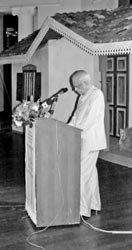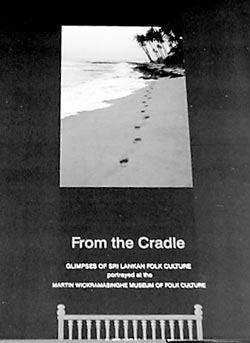
Echo of Koggala cradleA new book based on artefacts at the Martin Wickremasinghe museum sheds light on folk culture in Sri Lanka Charming girls dressed in the traditional, low-country reddha and hattaya, welcomed the invitees at the regal Galle Face Hotel, with a customary ayubowan. Creatively done banners lining the hallway showed various aspects of the lifestyle of an era bygone. And the multimedia device set up within the hall was ready to transport the audience back in time, enabling them to trace the life of a much revered Sri Lankan. The stage was set for the launch of “From the Cradle” — a beautifully nostalgic volume capturing the life of the great Martin Wickremasinghe. A venture to mark the 117th birth anniversary of Sri Lanka's most outstanding literary figure of the 20th century, this wonderful publication was the result of the hard work of a team of vastly knowledgeable individuals who were assisted by the Martin Wickremasinghe Trust.
Falling on May 29, his birth anniversary was commemorated by the release of the book, which deals with the subject closest to his heart — folk culture. The book is based on the artefacts displayed at the Martin Wickremasinghe Museum of Folk Culture, at Koggala, and contains vivid descriptions of the different aspects of folk culture in Sri Lanka. The launch held last week, was a simple, yet tastefully done ceremony with Minister Sarath Amunugama as the chief guest. Renowned script-writer and film director Tissa Abeysekera was the master-of-ceremonies, conducting the proceedings in his customary bilingual flair. Following the lighting of the traditional oil lamp, set up against the backdrop of a replica of Wickremasinghe's home, the launch began with a creative three-minute video tracing the Maestro's journey through life. Beginning literally from the moment he was born, and giving us glimpses of his childhood, family life and work, through the artefacts on display, the video was brilliantly done, with the visuals and lingering background score fitting perfectly with the mood. The video began with the sound of a newborn's cry, symbolizing the birth of this national asset, and a woman's voice saying “saramak,” telling the world that the baby was a boy — a joyful encounter in a patriarchal society.
Delivering addresses at the launch were Dr. Amunugama and Professor K.N.O Dharmadasa, taking all those present through an interesting journey, highlighting the comparisons and contrasts between Sinhala literature and other creations in the literary world, drawing examples from the great Chekhov and so on. Wickremasinghe's ability to gently but successfully make us connect with our culture and traditions was brought out in the addresses, while it was also pointed out that it was he who introduced the short story and novel to Sinhala literature. And as John Donne once quite rightly penned, “No man is an island unto himself” — literature being a classic example, proving that all cultures are interconnected through the bridge of humanity. The lavishly illustrated book, published by the Martin Wickremasinghe Trust, begins with a brief description of Koggala, the birth-place of this great man, and the house where he was born, around which the museum has been established. It goes on to discuss salient features of day to day activities of the people, highlighting some of the fast diminishing customs and traditions prevalent in the early days. For instance, the ‘guru gedara’ — the teacher's house where the village children learnt their first letters and the ‘veda gedara’ – the native physician's home, went hand-in-hand with the folk culture. The role of the village temple, the place given to rice in the daily menu, the busy housewife's paraphernalia, celebrations during Sinhala avurudu, modes of transport in the early days, and traditional customs are among the topics covered in the publication. The skilled craftsmen who supplied the necessities for the peasants to lead a simple life are described in great detail along with colourful photographs of their products which are housed in the folk museum. The experienced team working on the publication consisted of D.C. Ranatunga, well-known journalist and literary critic, who handled the text, while the photographs of the artefacts and settings were captured through the lens of renowned photographer Sarath Perera. The layout and design is by seasoned Somachandra Peiris, better known as Ruwan. The publication also includes two excellent features — one by Tissa Abeysekera and the other by Professor K. N. O. Dharmadasa, and also a complete list of Martin Wickremasinghe publications. "The idea of embarking on this venture came about a year ago, when I visited the Trust to get some pictures for an article I was doing for the Funday Times. Upon hearing of the suggestion to publish a volume such as this, based on the artefacts at the museum, the importance of giving life to the these wonderful objects, by merging them with real life situations, was realised. And so the journey began, with us going through novels such as Gamperaliya and Madol Doowa, to get a better idea of folk life in that era," said D.C, adding that they made about ten visits to Koggala throughout the project. A studio had been eventually set up by Sarath, while Ruwan arranged the delicate artefacts to get the best possible effect for the photographs. He also went on to say that the external shots were the toughest to accomplish, giving an interesting example of the tedious process of having to capture a footpath, the rail-track, the road, a bullock-cart and the sea in one frame, at the perfect moment, in Kathaluwa. He extended his thanks to the members of the Trust, family members, who guided the team and gave them ample freedom in putting together the publication, and Upasena Rajapaksha of the Martin Wickremasingha Museum of Folk Culture for his support. “This endeavour has been a fine learning experience for us and we hope that the publication would help create an appreciation for our rich, folk culture and help realise what a treasure trove it is.” “From the Cradle” will be available at Sarasa (Pvt) Ltd, at 8/3, Kirimandala Mawatha, Nawala, Rajagiriya, the distributors of publications of the Martin Wickremasinghe Trust. |
|| Front
Page | News | Editorial | Columns | Sports | Plus | Financial
Times | International | Mirror | TV
Times | Funday
Times || |
| |
Copyright
2007 Wijeya
Newspapers Ltd.Colombo. Sri Lanka. |

